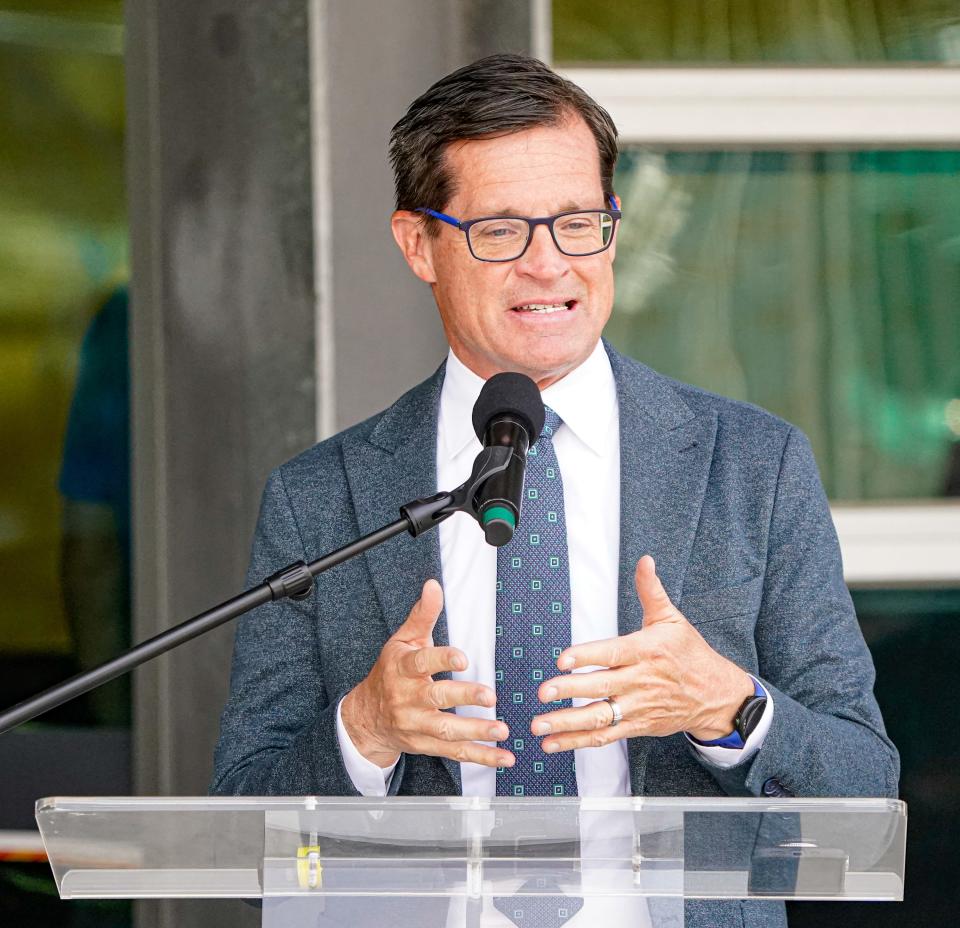Indy 500 grandstand sellout possible but lifting blackout hasn't been discussed yet
The Indianapolis Motor Speedway is nearing the number of grandstand ticket it sold in 2023 -- when it hosted more than 330,000 fans for the 107th Indianapolis 500 -- two weeks ahead of race day, IMS president Doug Boles told IndyStar on Wednesday. But until they get closer, conversations around lifting the local blackout of the live race broadcast haven't been seriously held.
After a review of its ticket sales last week revealed IMS had sold more than 90% of its roughly 234,000 grandstand seats days into the Month of May -- leaving more than 20,000 left on the market -- Boles told IndyStar at the 500 pace car unveiling that an internal review Wednesday morning showed the track now had just over 12,000 reserved grandstand seats remaining. A year ago, the track had just under 10,000 open reserved grandstand seats empty for Josef Newgarden and Marcus Ericsson's drag race to the finish that delivered Roger Penske his first 500 win as the track owner.
Indy 500 grandstand sellout 'definitely possible'
Should IMS continue on this pace, Boles said the track's second grandstand sellout in recent memory (the other in 2016) seems "definitely possible if this pace continues."

"We don't even really know if this is the 'Kyle Larson effect' (as he goes for the double) or just great momentum, because this just continues to be really strong," said Boles, who told IndyStar in February that IMS had been slightly tracking ahead of its 2016 sales numbers when the venue shutoff ticket sales during race week to mark its first complete sellout in race history. "Our ticket sales continue to be up day-over-day (on 2023).
"People just seem to be really excited."
Boles confirmed that a 2016-like sellout won't happen -- though we could certainly see one in the future, if IMS keeps trending up year-over-year, after hosting 325,000 fans in 2022 and an additional 6,000-8,000 more a year ago. As of last week, IMS had sold 15,000 more grandstand seats than it had compared to a similar time ahead of the 2023 edition. For its total sellout in 2016, IMS sold out of grandstand seats May 6, more than three weeks before race day. To have been on-pace with those numbers, IMS would've had to have sold its last grandstand ticket last Friday.
More: Inside IMS's consistent 500 ticket sales growth following 100th running in 2016
Boles: Formal talks around Indy 500 blackout haven't begun
Boles admitted the annual million-dollar-question of whether Penske Entertainment would reconsider its stance on a local live broadcast blackout of the 500 hasn't yet come across his desk. IMS has been in a handful of odd places with the quirky broadcast tradition in recent years, having lifted it for the complete sellout in 2016 for the first time since 1950 and then doing so again a couple years later when IMS hosted the 500 with no fans (2020) and only 135,000 (2021) due to the COVID-19 pandemic. In 2022, the over-the-air broadcast was blacked out for central Indiana race fans on their local NBC affiliate, but subscribers to the premium tier of NBC's Peacock streaming platform still had access to it.
Last year, IMS and NBC worked to geo-fence the traditional central Indiana ring to close off that loophole.
But this year, should ticket sales continue at this pace, Boles and those above him at Penske Entertainment will be faced with a decision regarding the blackout they haven't faced before: Should the grandstand sellout, but not the entire venue, lift the local live broadcast blackout?

In 2016, the track didn't announce the blackout was lifted until the total sellout was complete. The prevailing theory is that, at minimum, there wouldn't be an announcement on lifting the blackout until the desired result is complete.
But where this year is concerned, when IMS would still be expecting to sell $60 infield tickets up until moments before the pre-race pomp and circumstance, it seems likely they wouldn't make any sort of announcement about a change in protocol much before race weekend. Like it or not, that's what this age-old rule is about: protecting the financial success behind the world's largest single day sporting event.
History lesson: The saga of the Indy 500 TV blackout and its fascinating, quirky stronghold
"I'm sure we've all thought about it," Boles said of a potential local live broadcast blackout lift for this month. "But I don't know that we've had (formal) conversations about it. Certainly it's something in the back of your head, like, 'Okay, if you sell out the grandstands, what does that mean?'
"We've always said that if it's a sellout, we'd reconsider where we are with the rule. I've had a couple informal conversations with our ticketing team, just about where we are (on sales), so you can start thinking about timing and when (a sellout) might be. I just hope momentum keeps going, and then we'll deal with it when we get there."
This article originally appeared on Indianapolis Star: 12,000 Indy 500 grandstand tickets left. Will IMS lift the blackout?

